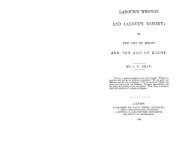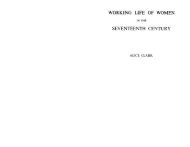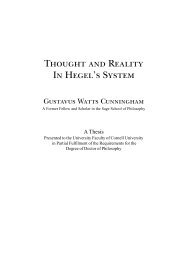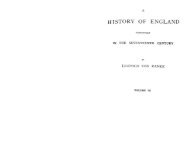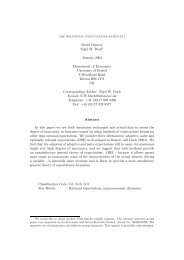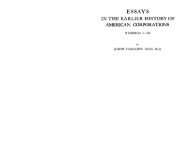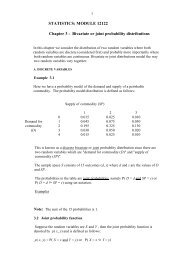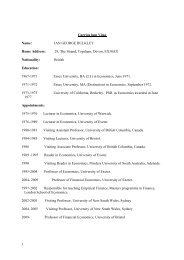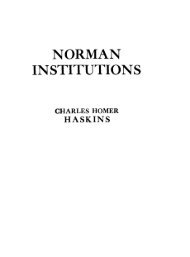The Constitutional History of England
The Constitutional History of England
The Constitutional History of England
You also want an ePaper? Increase the reach of your titles
YUMPU automatically turns print PDFs into web optimized ePapers that Google loves.
(iv) 1215-1272. <strong>The</strong> Charter : various editions, 1215, 1216,12 I 7, 1225 ; its chardcter ; beginning <strong>of</strong> statute book ; Statute <strong>of</strong>Merton (1236), <strong>of</strong> Marlborough (1267); the Barons' war. Study <strong>of</strong>jurisprudence : Bracton (ob I 268) ; Roman law and English ' caselaw '; evolution <strong>of</strong> con~mon law . . 14-18(v) I 272-1307. ' <strong>The</strong> English Justinian.' <strong>The</strong> great statutes,I 275 Westminster I, 1278 Gloucester, I 284 Wales, 1285 WestminsterI1 and Winchester, 1290 Westminster 111, 1297 ConjrnzatioCartaruwz ; their character and permanent importance. Edward asan administrator. Law books : Britton, Fleta. <strong>The</strong> first Year Book,1292. Check on growth <strong>of</strong> unenacted law. Roman law ceases tobe studied. Growth <strong>of</strong> class <strong>of</strong> lawyers. 'Common law,' contrastedwith statute, local custom, ecclesiastical law ; not yet with 'equity '18-23B. <strong>The</strong> Land Law.Reasons for starting with land law . . 23-24<strong>The</strong>ory <strong>of</strong> tenure. Subinfeudation : stopped by Statute <strong>of</strong>\Irestminster I1 ; the feudal formula A tenet terranz de B. Tenureand service. Classification <strong>of</strong> tenures : (I) frank almoign ; (2)knight's service ; the knight's fee ; homage, fealty ; aids, reliefs,prilner seisin, wardship, marriage, fines on alienation, escheat ;(3) grand serjeanty; (4) petty serjeanty ; ( 5) free socage; incidents<strong>of</strong> socage tenure ; (Note, classification <strong>of</strong> tenures not a classification<strong>of</strong> lands; the same land may be held by several tenures. Notemilitary service done only in the king's army ;) (6) villeinage ; villeinstatus and villein tenure ; tenencenturn no12 vtutat statunz . 24-35Definition <strong>of</strong> freehold ; li6er.um tener~zentum opposed to villanunttenemzntul~c ; afterwards also to chattel interests. Treatment <strong>of</strong>chattels; testamentary causes go to court christian; no wills <strong>of</strong>freehold ; primogeniture, its gradual spread.[<strong>The</strong> manor and its courts; court baron and customary court;who were the judges? I-Tad every manor freeholders? No moremanors to be created (rzgo).]Feudal ideal;-no connection between lord and vassal's vassal;this ideal to be had in mind that we may see how far it is realized35-39C. Divisions <strong>of</strong> the Realm and Local Goz~er~lntent.(i) <strong>The</strong> shire ; its history ; shire moot ; ealdorman ; sheriff; theNorman earl (comes) and Norman sheriff (z~iceconres). <strong>The</strong> countycourt (shire moot) not feudalized; its constitution; its politicalimportance ; quasi-corporate character <strong>of</strong> county ; acts as a wholefor many purposes ; election <strong>of</strong> coroners (I 194) ; struggle for electivesheriffs ; the county (court) represented in parliament . 39 -44(ii) <strong>The</strong> hundred ; its history, hundred moot : quasi-corporatecharacter <strong>of</strong> the hundred; its duties; represented in the eyres byjurors. Hundreds in private hands ; the court leet and the sheriffsturn ; the serjeant <strong>of</strong> the hundred . . . 44-46(iii) <strong>The</strong> vill or township; its duties; represented in the eyreby reeve and four men; election <strong>of</strong> the reeve. Relation <strong>of</strong> thetownship to the manor . . 47-52(iv) <strong>The</strong> boroughs; each borough has its own history, generali~ationdifficult. Privileges <strong>of</strong> boroughs may be brought under severalheads : (a) immunities ; (6) courts <strong>of</strong> their own, like hundred-courts ;(c) elective <strong>of</strong>ficers, baillivi, prmpositi; (d) collection <strong>of</strong> royal dues,thejma burgi; (e) guilds. <strong>The</strong> city <strong>of</strong> London. <strong>The</strong> notion <strong>of</strong> acorporation (juristic person) not yet formed; but the greater townshave what are afterwards regarded as the powers <strong>of</strong> corporatiolls52-54D. Central Goz)ernme~ct.Retrospect :-(1) Before 1066. King and witan; actual composition <strong>of</strong>witenagemot; theory that it had been a folk moot; the bishop;the ealdorman ; the thane (minuter regis). Tendency to\\ ardsfeudalism. I'owers <strong>of</strong> this assembly ; election and deposition <strong>of</strong>kings, appointment <strong>of</strong> <strong>of</strong>ficers, legislation, judicature, etc. ; but reallythere is little central government. Kingship increases in splendour :but rather in splendour than in power . . 54-60(ii) 1066-1154. Title to the kingship ; practical despotism <strong>of</strong>Norman kings; tradition <strong>of</strong> counsel and consent maintained. <strong>The</strong>Cz~ria Regis, how far formed on feudal lines ; number <strong>of</strong> tenants inchief; suit <strong>of</strong> court a burden. <strong>The</strong> ct~ria Regis in a narrower sense ;the administrati~e body; the <strong>of</strong>ficers <strong>of</strong> state, justiciar, chancellor;the exchequer and its routine . . 60-64(iii) I 154-1 2 16. Definition in Charter (I 2 15) <strong>of</strong> commz~necotlsiliunz regni. Who were the 6lzrones nzajores and what was abaronia? Line <strong>of</strong> demarcation gradually drawn among tenants inchief. Assemblies under Henry 11; consent to legislation andtaxation. <strong>The</strong> administrative and judicial body ; pr<strong>of</strong>essiona! judgesunder Henry I1 ; itinerant judges ; the barons <strong>of</strong> the exchequer



